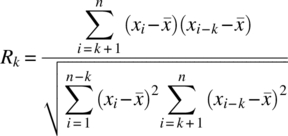17Autocorrelation
Autocorrelation is a correlation of a set of values with itself, sometimes also called serial correlation. External inputs are not considered. We apply Equation (4.75) to check for a correlation between a value measured now and the same measurement taken earlier, where k is the number of collection intervals between the two.

One use is to identify if there is a repetitive pattern. For example, Figure 17.1 shows a noisy measurement taken every second for 10 minutes. At first glance it might appear that the underlying measurement is constant. However, by determining the Pearson correlation coefficient (R) at different values of k, we can see from the correlogram (shown as Figure 17.2) that the correlation varies cyclically. The strongest positive correlation occurs at regular intervals of about 180 seconds, as does the strongest negative correlation. This tells us that the apparently constant measurement has an underlying oscillation with a period of about three minutes. This might highlight a previously undetected problem with controller tuning or an issue with the control valve. Indeed this technique forms the basis of some controller oscillation detection techniques. The correlogram has the same frequency of oscillation as the raw measurement but with a much improved signal‐to‐noise ratio – making automatic detection of oscillation more reliable.
Get Statistics for Process Control Engineers now with the O’Reilly learning platform.
O’Reilly members experience books, live events, courses curated by job role, and more from O’Reilly and nearly 200 top publishers.

